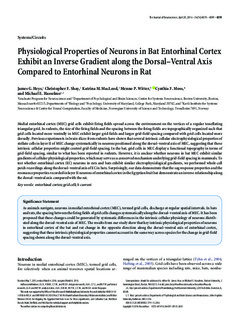| dc.contributor.author | Heys, James G | |
| dc.contributor.author | Shay, Christopher F | |
| dc.contributor.author | MacLeod, Katrina M | |
| dc.contributor.author | Witter, Menno | |
| dc.contributor.author | Moss, Cynthia F | |
| dc.contributor.author | Hasselmo, Michael E | |
| dc.date.accessioned | 2017-12-13T12:55:16Z | |
| dc.date.available | 2017-12-13T12:55:16Z | |
| dc.date.created | 2017-01-05T15:11:22Z | |
| dc.date.issued | 2016 | |
| dc.identifier.citation | Journal of Neuroscience. 2016, 36 (16), 4591-4599. | nb_NO |
| dc.identifier.issn | 0270-6474 | |
| dc.identifier.uri | http://hdl.handle.net/11250/2471196 | |
| dc.description.abstract | Medial entorhinal cortex (MEC) grid cells exhibit firing fields spread across the environment on the vertices of a regular tessellating triangular grid. In rodents, the size of the firing fields and the spacing between the firing fields are topographically organized such that grid cells located more ventrally in MEC exhibit larger grid fields and larger grid-field spacing compared with grid cells located more dorsally. Previous experiments in brain slices from rodents have shown that several intrinsic cellular electrophysiological properties of stellate cells in layer II of MEC change systematically in neurons positioned along the dorsal–ventral axis of MEC, suggesting that these intrinsic cellular properties might control grid-field spacing. In the bat, grid cells in MEC display a functional topography in terms of grid-field spacing, similar to what has been reported in rodents. However, it is unclear whether neurons in bat MEC exhibit similar gradients of cellular physiological properties, which may serve as a conserved mechanism underlying grid-field spacing in mammals. To test whether entorhinal cortex (EC) neurons in rats and bats exhibit similar electrophysiological gradients, we performed whole-cell patch recordings along the dorsal–ventral axis of EC in bats. Surprisingly, our data demonstrate that the sag response properties and the resonance properties recorded in layer II neurons of entorhinal cortex in the Egyptian fruit bat demonstrate an inverse relationship along the dorsal–ventral axis compared with the rat. | nb_NO |
| dc.language.iso | eng | nb_NO |
| dc.publisher | Society for Neuroscience | nb_NO |
| dc.rights | Navngivelse 4.0 Internasjonal | * |
| dc.rights.uri | http://creativecommons.org/licenses/by/4.0/deed.no | * |
| dc.title | Physiological properties of neurons in bat entorhinal cortex exhibit an inverse gradient along the dorsal–ventral axis compared to entorhinal neurons in rat | nb_NO |
| dc.type | Journal article | nb_NO |
| dc.type | Peer reviewed | nb_NO |
| dc.description.version | publishedVersion | nb_NO |
| dc.source.pagenumber | 4591-4599 | nb_NO |
| dc.source.volume | 36 | nb_NO |
| dc.source.journal | Journal of Neuroscience | nb_NO |
| dc.source.issue | 16 | nb_NO |
| dc.identifier.doi | 10.1523/JNEUROSCI.1791-15.2016 | |
| dc.identifier.cristin | 1421834 | |
| dc.relation.project | Norges forskningsråd: 223262 | nb_NO |
| dc.description.localcode | Copyright©2016 the authors. Articles are released under a Creative Commons Attribution License after a 6 months embargo. | nb_NO |
| cristin.unitcode | 194,65,60,0 | |
| cristin.unitname | Kavliinstitutt for nevrovitenskap | |
| cristin.ispublished | true | |
| cristin.fulltext | postprint | |
| cristin.qualitycode | 2 | |

